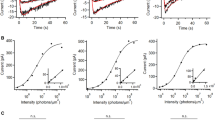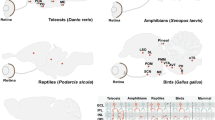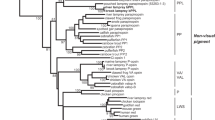Abstract
Non-mammalian vertebrates have an intrinsically photosensitive iris and thus a local pupillary light reflex (PLR). In contrast, it is thought that the PLR in mammals generally requires neuronal circuitry connecting the eye and the brain. Here we report that an intrinsic component of the PLR is in fact widespread in nocturnal and crepuscular mammals. In mouse, this intrinsic PLR requires the visual pigment melanopsin; it also requires PLCβ4, a vertebrate homologue of the Drosophila NorpA phospholipase C which mediates rhabdomeric phototransduction. The Plcb4−/− genotype, in addition to removing the intrinsic PLR, also essentially eliminates the intrinsic light response of the M1 subtype of melanopsin-expressing, intrinsically photosensitive retinal ganglion cells (M1-ipRGCs), which are by far the most photosensitive ipRGC subtype and also have the largest response to light. Ablating in mouse the expression of both TRPC6 and TRPC7, members of the TRP channel superfamily, also essentially eliminated the M1-ipRGC light response but the intrinsic PLR was not affected. Thus, melanopsin signalling exists in both iris and retina, involving a PLCβ4-mediated pathway that nonetheless diverges in the two locations.
This is a preview of subscription content, access via your institution
Access options
Subscribe to this journal
Receive 51 print issues and online access
$199.00 per year
only $3.90 per issue
Buy this article
- Purchase on Springer Link
- Instant access to full article PDF
Prices may be subject to local taxes which are calculated during checkout






Similar content being viewed by others
References
Berson, D. M., Dunn, F. A. & Takao, M. Phototransduction by retinal ganglion cells that set the circadian clock. Science 295, 1070–1073 (2002)
Hattar, S., Liao, H.-W., Takao, M., Berson, D. M. & Yau, K.-W. Melanopsin-containing retinal ganglion cells: architecture, projections, and intrinsic photosensitivity. Science 295, 1065–1070 (2002)
Bailes, H. J. & Lucas, R. J. Melanopsin and inner retinal photoreception. Cell. Mol. Life Sci. 67, 99–111 (2010)
Do, M. T. H. & Yau, K.-W. Intrinsically photosensitive retinal ganglion cells. Physiol. Rev. 90, 1547–1581 (2010)
Hankins, M. W., Peirson, S. N. & Foster, R. G. Melanopsin: an exciting photopigment. Trends Neurosci. 31, 27–36 (2008)
Nayak, S. K., Jegla, T. & Panda, S. Role of a novel photopigment, melanopsin, in behavioral adaptation to light. Cell. Mol. Life Sci. 64, 144–154 (2007)
Barr, L. Photomechanical coupling in the vertebrate sphincter papillae. Crit. Rev. Neurobiol. 4, 325–366 (1989)
Seliger, H. H. Direct action of light in naturally pigmented muscle fibers. I. Action spectrum for contraction in eel iris sphincter. J. Gen. Physiol. 46, 333–342 (1962)
Barr, L. & Alpern, M. Photosensitivity of the frog iris. J. Gen. Physiol. 46, 1249–1265 (1963)
Kargacin, G. J. & Detwiler, P. B. Light-evoked contraction of the photosensitive iris of the frog. J. Neurosci. 5, 3081–3087 (1985)
Tu, D. C., Batten, M. L., Palzewski, K. & Van Gelder, R. N. Nonvisual photoreception in the chick iris. Science 306, 129–131 (2004)
Bito, L. Z. & Turansky, D. G. Photoactivation of pupillary constriction in the isolated in vitro iris of a mammal (Mesocricetus auratus). Comp. Biochem. Physiol. 50A, 407–413 (1975)
Lau, K. C., So, K.-F., Campbell, G. & Lieberman, A. R. Pupillary constriction in response to light in rodents, which does not depend on central neural pathways. J. Neurol. Sci. 113, 70–79 (1992)
Oyster, C. W. The Human Eye: Structure and Function (Sinauer, 1999)
Do, M. T. H. et al. Photon capture and signalling by melanopsin retinal ganglion cells. Nature 457, 281–287 (2009)
Blanchong, J. A., McElhinny, T. L., Mahoney, M. M. & Smale, L. Nocturnal and diurnal rhythms in the unstriped Nile rat, Arvicanthis niloticus . J. Biol. Rhythms 14, 364–377 (1999)
Govardovskii, V. I., Fyhrquist, N., Reuter, T., Kuzmin, D. G. & Donner, K. In search of the visual pigment template. Vis. Neurosci. 17, 509–528 (2000)
Lucas, R. J. et al. Diminished pupillary light reflex at high irradiances in melanopsin-knockout mice. Science 299, 245–247 (2003)
Lem, J. et al. Morphological, physiological, and biochemical changes in rhodopsin knockout mice. Proc. Natl Acad. Sci. USA 96, 736–741 (1999)
Vitaterna, M. H. et al. Differential regulation of mammalian period genes and circadian rhythmicity by cryptochromes 1 and 2. Proc. Natl Acad. Sci. USA 96, 12114–12119 (1999)
Ghosh, S., Salvador-Silva, M. & Coca-Prados, M. The bovine iris-ciliary epithelium expresses components of rod phototransduction. Neurosci. Lett. 370, 7–12 (2004)
Provencio, I., Jiang, G., De Grip, W. J., Hayes, W. P. & Rollag, M. D. Melanopsin: An opsin in melanophores, brain, and eye. Proc. Natl Acad. Sci. USA 95, 340–345 (1998)
Yau, K.-W. & Hardie, R. C. Phototransduction motifs and variations. Cell 139, 246–264 (2009)
Berridge, M. J. Smooth muscle cell calcium activation mechanisms. J. Physiol. 586, 5047–5061 (2008)
Gonzalez-Cobos, J. C. & Trebak, M. TRPC channels in smooth muscle cells. Front. Biosci. 15, 1023–1039 (2010)
Jiang, H. et al. Phospholipase C β4 is involved in modulating the visual response in mice. Proc. Natl Acad. Sci. USA 93, 14598–14601 (1996)
Suzuki, M., Mizuno, A., Kodaira, K. & Imai, M. Impaired pressure sensation in mice lacking TRPV4. J. Biol. Chem. 278, 22664–22668 (2003)
Zucker, R. & Nolte, J. Light-induced calcium release in a photosensitive vertebrate smooth muscle. Nature 274, 78–80 (1978)
Graham, D. M. et al. Melanopsin ganglion cells use a membrane-associated rhabdomeric phototransduction cascade. J. Neurophysiol. 99, 2522–2532 (2008)
Venkatachalam, K. & Montell, C. TRP channels. Annu. Rev. Biochem. 76, 387–417 (2007)
Hattar, S. et al. Melanopsin and rod-cone photoreceptive systems account for all major accessory visual functions in mice. Nature 424, 75–81 (2003)
Allen, A. E., Cameron, M. A., Brown, T. M., Vugler, A. A. & Lucas, R. J. Visual responses in mice lacking critical components of all known retinal phototransduction cascades. PLoS ONE 5, e15063 (2010)
Organisciak, D. T. & Vaughan, D. K. Retinal light damage: Mechanisms and protection. Prog. Retin. Eye Res. 29, 113–134 (2010)
Grozdanic, S. et al. Characterization of the pupil light reflex, electroretinogram and tonometric parameters in healthy mouse eyes. Curr. Eye Res. 26, 371–378 (2003)
Zhu, Y. et al. Melanopsin-dependent persistence and photopotentiation of murine pupillary light responses. Invest. Ophthalmol. Vis. Sci. 48, 1268–1275 (2007)
Bellingham, J., Whitmore, D., Philp, A. R., Wells, D. J. & Foster, R. G. Zebrafish melanopsin: isolation, tissue localisation and phylogenetic position. Brain Res. Mol. Brain Res. 107, 128–136 (2002)
Chaurasia, S. S. et al. Molecular cloning, localization and circadian expression of chicken melanopsin (Opn4): differential regulation of expression in pineal and retinal cell types. J. Neurochem. 92, 158–170 (2005)
Panda, S. et al. Illumination of the melanopsin signaling pathway. Science 307, 600–604 (2005)
Qiu, X. et al. Induction of photosensitivity by heterologous expression of melanopsin. Nature 433, 745–749 (2005)
Isoldi, M. C., Rollag, M. D., Castrucci, A. M. & Provencio, I. Rhabdomeric phototransduction initiated by the vertebrate photopigment melanopsin. Proc. Natl Acad. Sci. USA 102, 1217–1221 (2005)
Gomez, M., del P, Angueyra, J. M. & Nasi, E. Light-transduction in melanopsin-expressing photoreceptors of Amphioxus. Proc. Natl Acad. Sci. USA 106, 9081–9086 (2009)
Koyanagi, M., Kubokawa, K., Tsukamoto, H., Shichida, Y. & Terakita, A. Cephalochordate melanopsin: evolutionary linkage between invertebrate visual cells and vertebrate photosensitive retinal ganglion cells. Curr. Biol. 15, 1065–1069 (2005)
Warren, E. J., Allen, C. N., Brown, R. L. & Robinson, D. W. The light-activated signaling pathway in SCN-projecting rat retinal ganglion cells. Eur. J. Neurosci. 23, 2477–2487 (2006)
Sekaran, S. et al. 2-Aminoethoxydiphenylborane is an acute inhibitor of directly photosensitive retinal ganglion cell activity in vitro and in vivo . J. Neurosci. 27, 3981–3986 (2007)
Hartwick, A. T. et al. Light-evoked calcium responses of isolated melanopsin-expressing retinal ganglion cells. J. Neurosci. 27, 13468–13480 (2007)
Terakita, A. et al. Expression and comparative characterization of Gq-coupled invertebrate visual pigments and melanopsin. J. Neurochem. 105, 883–890 (2008)
Lin, B., Koizumi, A., Tanaka, N., Panda, S. & Masland, R. H. Restoration of visual function in retinal degeneration mice by ectopic expression of melanopsin. Proc. Natl Acad. Sci. USA 105, 16009–16014 (2008)
Peng, Y. W. et al. Identification of components of a phosphoinositide signaling pathway in retinal rod outer segments. Proc. Natl Acad. Sci. USA 94, 1995–2000 (1997)
Perez-Leighton, C. E., Schmidt, T. M., Abramowitz, J., Birnbaumer, L. & Kofuji, P. Intrinsic phototransduction persists in melanopsin-expressing ganglion cells lacking diacylglycerol-sensitive TRPC subunits. Eur. J. Neurosci. 33, 856–867 (2011)
Cahill, H. & Nathans, J. The optokinetic reflex as a tool for quantitative analyses of nervous system function in mice: application to genetic and drug-induced variation. PLoS ONE 3, e2055 (2008)
Acknowledgements
We thank the following individuals for providing knockout mouse lines: M. Caterina (Trpv4−/−), J. Lem (Rho−/− and Gnat1−/−), J. C. Chen (Rho−/−), J. Nathans (cl, also known as cone-DTA), A. Sancar (Cry1−/− Cry2−/− ) and L. Birnbaumer (Trpc1−/−, Trpc3−/− and Trpc6−/−). We thank D. Marshak, R. von der Heydt, X. Wang and V. Casagrande for eyes from baboon, rhesus monkey, marmoset and bush baby, respectively, and W. Li, R. Mi, B. O’Rourke, L. Pipitone, D. Ruben, D. Ryugo, L. Smale and G. Tomaselli for eyes of other animals. Experiments on bush baby were carried out in the Casagrande laboratory with help and hospitality. We also thank W. Gao for suggestions on the force transducer, F. Rieke and A. Sampath for suggestions on the design of the LED light system, P. Ala-Laurila for the method of equivalent 480-nm-photon conversion, H. Cahill for the mouse-head-anchoring method, X. Ren for help on western blots, O. Garalde and A. Chen for help in the monkey experiments, and W. W. S. Yue for help on RT–PCR. We also thank T. Shelley for fabricating all custom equipment, S. Kulason for help in data analysis, and L. Ding for mouse-genotyping support. Members of the Yau laboratory provided comments on the manuscript. This work was supported by US NIH Grant EY14596 and the António Champalimaud Vision Award (Portugal) to K.-W.Y.
Author information
Authors and Affiliations
Contributions
T.X., M.T.H.D. and K.-W.Y. designed the experiments. T.X. and M.T.H.D. did the isolated-eyeball experiments. T.X. carried out all muscle recordings and also Trpc knockout ipRGC recordings at 23 °C (recordings at 35°C were by Z.J.), the mouse-optic-nerve transections, some of the in situ PLR measurements (the rest done by J.H.), some of the RT–PCR experiments on melanopsin (the rest done by H.C.W.), the tdTomato-fluorescence experiments, and the generation and maintenance of all double, triple and quadruple genetically engineered mouse lines for this study. The recordings from ipRGCs of Plcb4−/− mice and their wild-type littermates were done by M.T.H.D. (23 °C) and Z.J. (35 °C). T.X., M.T.H.D. and J.H. designed the head-fixed, dual-PLR-recording instrument. T.X. and H.C.W. did the anterior-chamber measurements. H.C.W. did the immunocytochemistry and X-gal labelling. S.L.M. and D.S.W. did the surgery of transecting the optic nerve in anaesthetized monkeys, and tested the PLR with T.X. and M.T.H.D. T.Y. participated in the monkey experiments. A.R. in D.E.C.’s laboratory made the Trpc7−/− mouse line and did the associated characterization (retinal RT–PCR done by T.X.). P.W., S.S., V.F. and M.F. made the Trpc5−/− line and did the associated characterization, and also provided the Trpc4−/− and Trpc4−/− Trpc5−/− lines. M.I.S. provided the Plcb4−/− line. T.X., M.T.H.D. and Z.J. analysed the data with assistance from J.H., and, together with K.-W.Y., wrote the paper.
Corresponding authors
Ethics declarations
Competing interests
The authors declare no competing financial interests.
Supplementary information
Supplementary Information
The file contains Supplementary Text, Supplementary Methods and Supplementary Figures 1-11 with legends. (PDF 765 kb)
Rights and permissions
About this article
Cite this article
Xue, T., Do, M., Riccio, A. et al. Melanopsin signalling in mammalian iris and retina. Nature 479, 67–73 (2011). https://doi.org/10.1038/nature10567
Received:
Accepted:
Published:
Issue Date:
DOI: https://doi.org/10.1038/nature10567
This article is cited by
-
Melanopsin-mediated optical entrainment regulates circadian rhythms in vertebrates
Communications Biology (2023)
-
Visual Disturbances After Concussion
Current Physical Medicine and Rehabilitation Reports (2023)
-
A neuropsin-based optogenetic tool for precise control of Gq signaling
Science China Life Sciences (2022)
-
Expression and Functional Role of Olfactory, Taste, and Phototransduction Signal Proteins in β Cells in Islets of Langerhans
Neuroscience and Behavioral Physiology (2022)
-
Molecular determinants of response kinetics of mouse M1 intrinsically-photosensitive retinal ganglion cells
Scientific Reports (2021)
Comments
By submitting a comment you agree to abide by our Terms and Community Guidelines. If you find something abusive or that does not comply with our terms or guidelines please flag it as inappropriate.



